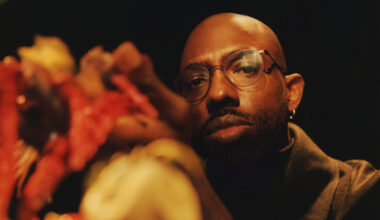Krautrock aficionado and one-time Stereolab man Tim Gane takes time off from his Cavern of Anti-Matter project to tell us what makes his creative juices bubble

Childhood wardrobe
“I grew up in Manor Park in east London and I used to have this old wardrobe in my bedroom. It was the first thing I saw when I woke up and I would stare at it for what seemed like years. It was very chaotic, but you could see lots of faces and creatures in the wood grain. Some of them would change and some would always be there. I remember being fascinated by this wardrobe all through my childhood. Even now, I could just lie on my back and look at the clouds for an hour, seeing shapes form and filling the rest in with my mind.
“When I do music, I think I’m doing the same thing without consciously realising it – looking for patterns, looking for shapes. I’m very locked into hearing hidden little melodies or rhythmic ideas that I home in on and use as a springboard. I’ve always looked at music like that – not composing a structured song, more just having these little ideas going on and seeing where I can take them. I think it counts as a kind of influence, even though it’s a subliminal one. Maybe it teaches you a way of looking at things, a way of working. I think most people do it… it’s just whether they’ve had the opportunity to wake up and look at an old wardrobe!”
Throbbing Gristle
“I originally left school at 16, but went back to sixth form because I didn’t want to get a job. Then for one of my courses, I had to write to different employers, so I wrote to four record labels. One was Industrial Records, Throbbing Gristle’s label. Thinking back, I suppose they might have thought it was hilarious, but they answered it seriously and sent me lots of stuff. When I read the Industrial newsletter, I got really into the idea of what they were doing.
“Throbbing Gristle were interested in all these strange subjects and they lived their lives 100 per cent. It turned me against the idea of dressing up to become a persona on stage and then going back to being normal. I liked the thought that you could be exactly like that all the time, being and living what you’re doing totally. There’s an intensity to that which fascinated me. I also liked that Throbbing Gristle were down to earth in the way they conducted themselves, not revelling in high art. That’s really stayed with me. I’ve always thought that every record you make is one part of the whole thing and the process you go through to arrive there is just as important. A record is only a document of your current activities.”
Film titles
“I’ve always been obsessed with film titles. When I was 11, we had a television with a DIN socket, a little connection where you could plug in a cassette recorder. I’d sit there and tape the titles of lots of films – just the music, because there was no video then. I remember particularly loving Sergio Leone’s ‘Dollars’ trilogy, which had music by Ennio Morricone. Every time they came on, I had to watch them, and those crazy explosions of colour and movement always blew my mind. I also remember having ‘Get Carter’ and ‘Journey To The Centre Of The Earth’. And ‘The Sweeney’, which had upbeat music at the beginning and then a sad version of the same music at the end. I never knew why that was. This was before I was interested in music in a wider sense. It all exploded when I was about 13, but before that I wasn’t buying records or following the charts.
“Later on, when the first video machines appeared, I remember you could do really weird things. We used to tape our own music on top of the titles and make soundtracks to films. I’ve always loved the way music goes with images, but also just letters moving from the bottom of the screen to the top. So, yeah, film titles instilled a certain idea in me about music and what it can do, because you can understand abstract things when it’s associated with images.”
Fostex X-15
“It’s a four-track cassette recorder. I got one in around 1983. You put cassettes in and it’s got four tracks using both sides of the cassette. It was black and orange, built like a tank, really heavy and solid. I began to do music on it with the first group I had. It was all electronic stuff and I really enjoyed the layering. The way it worked meant you had to change how you thought about music. It was electronic music but I did everything with a guitar… no drum machines and hardly any keyboards, apart from maybe a little bit of Casio every 40 pieces or something.
“Gradually, the way that I played the guitar evolved and changed because of using the machine. It accentuated a certain frequency near the bottom and you could clearly hear all the lower strings in a different kind of inversion. You’d sit in a little room with your guitar and your headphones, really close up, recording and stopping and listening. That really close intimacy with the device, combined with the limitations of the four-track, having to bounce stuff down all the time… it influenced the way that I wrote music. This was true throughout my time in McCarthy and in Stereolab as well. In fact, I used my Fostex right up until around 2003, when eventually it broke. It didn’t have very good sound quality, but what it did really focused my mind to hear the tiny details in sound.”
Cavern Of Anti-Matter’s ‘Void Beats/Invocation Trex’ album is out on Duophonic





